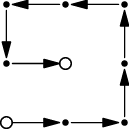You are given a rectangular grid consisting of r × c points. The lower left corner has coordinates (1,1), the upper right corner has coordinates (c,r). The neighbors of a point (x,y) are the points (x − 1,y), (x + 1,y), (x,y − 1), and (x,y + 1), if they exist. A path is a sequence of points such that subsequent points are neighbors and each point appears on the path at most once.
Problem specification
Given two distinct points (xs,ys) and (xf,yf), find one longest path from (xs,ys) to (xf,yf).
Input specification
The first line of the input file contains an integer t specifying the number of test cases. Each test case is preceded by a blank line.
Each test case consists of a single line with six integers – r, c, xs, ys, xf, yf.
For both the easy subproblem G1 and the hard subproblem G2, you may assume that 1 ≤ r,c ≤ 100 and rc ≥ 2. Additionally, for the easy subproblem G1 you may assume that r ≤ 5.
Output specification
For each test case, output a single string describing one possible longest path. If there are multiple longest paths, output any one of them.
A path a1,a2,…,ak is described by a string consisting of k − 1 letters U, D, L, R. The i-th letter in the string
describes the move from point ai to ai+1:
If ai = (x,y) and ai+1 = (x,y + 1), the i-th letter should be U.
If ai = (x,y) and ai+1 = (x,y − 1), the i-th letter should be D.
If ai = (x,y) and ai+1 = (x + 1,y), the i-th letter should be R.
If ai = (x,y) and ai+1 = (x − 1,y), the i-th letter should be L.
Example
first example:

second example:
